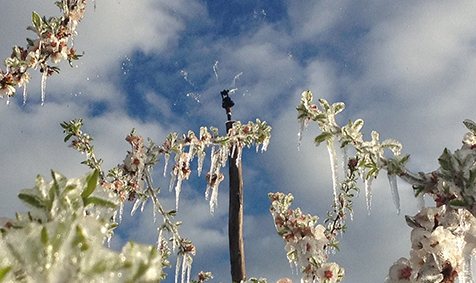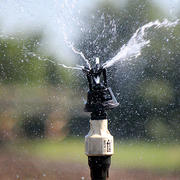
Low temperatures under 32 °F (0 °C) and freezing conditions present a great threat to crop growth and could result in partial or total losses if not handled appropriately.
Sprinkler irrigation can provide the highest level of protection when compared to a vast majority of currently available systems. It is also one of the most economical frost control alternatives.
A sprinkler system’s energy consumption is considerably less than what growers normally would spend with heaters and other electrical equipment. The labor requirements are less when compared to these other methods and it is relatively non-polluting.
How it Works
Frost protection depends on the principle of heat fusion to maintain plant temperature at or near 32˚ F (0˚ C).
Essentially, as the air temperature surrounding the plants drops below freezing levels, the water begins to freeze and crystalize, releasing approximately 80 calories of heat for every 0.03 ounces (1 gram) of water that freezes. As the ice encases the plant it partially insulates it from the harsh exterior temperatures.
Sprinklers provide a 2 to 5-degree temperature difference, which is just enough to protect the plants.
As long as water is constantly wetting the plant, the system should successfully protect them from severe damage. The ice should appear relatively clear. If there is a clear liquid-ice mixture coating the plants and water is dripping off the ice, then the application rate is sufficient to prevent damage. If the water freezes and has a milky white appearance, then the application rate is too low for the weather conditions.* Thus, the water application must be much more uniform than required for irrigation so that no area receives less than the designated amount.

What You Need
Wobbler sprinklers gently apply a consistent and uniform layer of water over plants to keep them covered in ice at all times. This prevents sudden loss of heat.
The droplets produced by these sprinklers are consistently sized and large enough to resist wind drift – thereby preserving the pattern’s integrity – but gentle enough to prevent damage to plants. Their constant rotary action also prevents ice buildup and prevents the sprinkler from freezing. In addition, less water is needed for achieving an equal result when compared to stream-driven devices.
System Requirement
Ideally, over-plant sprinklers for frost protection should re-apply water constantly over the entire plant to help ensure that the area receives a sufficient application rate to prevent the plant tissue from losing heat energy and possible plant damage. For frost protection, sources suggest a minimum coefficient of uniformity (CU) of 80%.
This means the water application needs to be much more uniform than what’s required for irrigation so that no area receives less than the designated amount.
Application rate requirements for overhead sprinklers are different based on the sprinkler type, wind speed, minimum temperature, and crop type. As long as there is a liquid-ice mixture on the plants, with the water dripping off the icicles, the coated plant parts will be protected.
Factors To Consider
- Forecasting the minimum temperature and how it might change during the night is key to decide if protection is needed and when to start the system
- Verify the system before an expected frost event
- Turn on the system when the wet-bulb temperature is higher than the critical damage temperature**
- Ensure water is applied continuously
- Don’t shut down the system too early. Even if the sun is shining on the plants and the air temperature is above 32°F (0°C), sprinklers should not be turned off unless the wet-bulb temperature measured upwind from the crop is above the critical damage temperature**
- Consider it essencial to invest in a backup power source
- Consult with the local extension service to know the recommended precipitation rate based on your crop
* For best results, Senninger recommends the use of weather tools, such as psychrometers. Weather tools can alert orchard managers of upcoming frost events and help managers better prepare.
* **For detailed information about start-up and shut-down temperatures, see chapter 2, table 2.2 of Frost Protection Fundamentals, Practice, and Economics by the Food and Agriculture Organization of the United Nations, Volume 1.
This document is intended only as a reference tool for typical application considerations and may not apply to all systems or conditions. The information is supplied upon the condition that the persons receiving same will make their own determination as to its suitability for their purposes prior to use. In no event will Senninger Irrigation Inc. be responsible for damages of any nature whatsoever resulting from the use of or reliance upon information from this document or the products to which the information refers.


